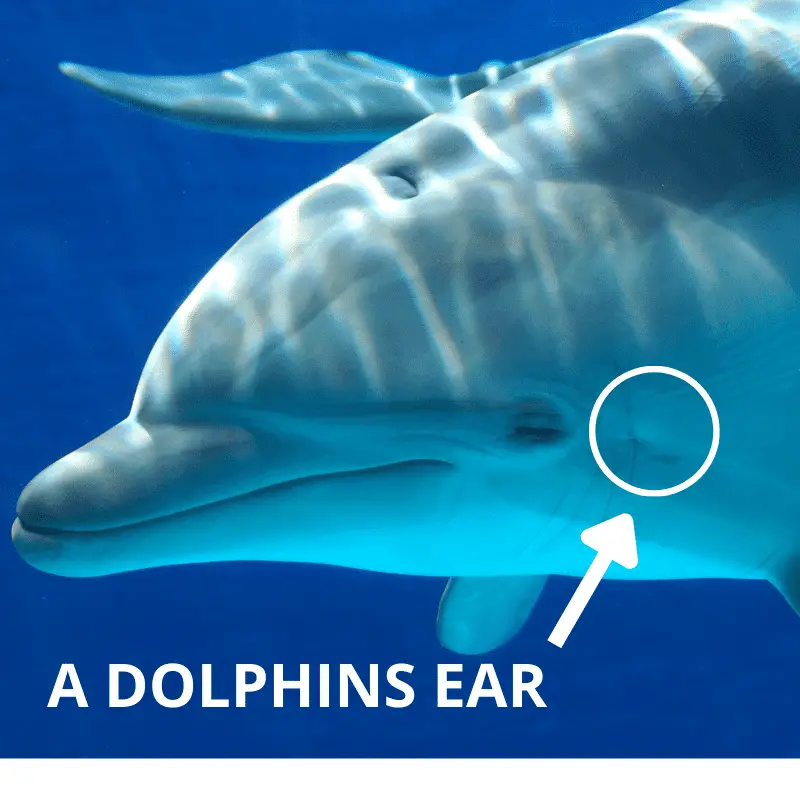The hearing range of dolphins is more extensive than most other living species. Dolphins can hear sounds underwater and above the water. Dolphins communicate with each other using complex techniques known as sonar and echolocation; this also helps them to hunt and navigate.
The complex hearing ability of the dolphins also allows them to hear sounds of particular frequencies that humans cannot hear.
Now we know a dolphin can hear. Let’s learn how a dolphin hears and its unique techniques.
Do dolphins have ears? Where are they located?
No, dolphins do not have visible external ears. However, they can still hear because they have a small ear opening on both sides of their head that leads to the middle and inner ear canal.

How Do Dolphins Hear?
Even though the dolphins do not have external ears, they can hear sounds through these openings when they are not underwater. They close these openings when the dolphins go underwater, making them watertight.
To listen to sounds underwater, the dolphins use their lower jawbones. The unique structure of the lower jaw bone allows it to conduct the sound into the middle ear of a dolphin.
Hearing Techniques
Dolphins use sound to communicate with each other and find their prey. Their exceptional hearing ability helps them navigate underwater, even if it is very murky. They can also use echolocation to locate particular objects and organisms underwater.
Echolocation
Echolocation is also called biosonar. Echolocation is used for navigating, locating prey, and foraging in various environments many animals use.
How A Dolphin Uses Echolocation
Echolocation is used only underwater, enabling dolphins to locate various objects and prey underwater.
As sound waves can travel faster in the water than in the air, dolphins can communicate with other species members located miles away.
While communicating using the echolocation technique, a dolphin will generate high-pitched clicking sounds.
The echo sound is then returned to the dolphin when this sound gets bounced off of various objects, helping the dolphin to understand the location of a particular object or prey.
Through echolocation, the dolphins can even determine the distance of objects and then navigate according to them.
The dolphins receive the returning sound vibrations in their lower jawbone.
Returned Hearing Information
The data an animal receives back is of many kinds.
- Type of animal
- Size
- Distance
- Texture
The Echolocation method works perfectly underwater because, compared to the air, water is an excellent transmitter of sound.
Underwater sound travels five times faster than it travels in the air.
The dolphins use this water feature to their advantage while communicating through echolocation. This communication process helps the dolphins stay connected, which, in turn, helps them avoid predators and find food quickly.
Echolocation Techniques Used By Animals
Other than dolphins, several other animals also use echolocation.





- Bats
- Dolphins
- Door Mouses
- Hedgehogs
- Oilbirds
- Porpisoes
- Shrews
- Swiftlets
- Tenrecs
- Whales
Echolocation Jamming
The echolocation sound system can also be susceptible to jamming. Jamming happens when non-target sounds interrupt and cross paths with other target sounds. Sometimes this jamming occurs by mistake and also can be caused on purpose.
Causes
- Humans, such as human radars
- Other animals, such as a moth, can jam a bat’s echolocation sonar
- Background noises
Reduced Visibility – Sonar Technique
Sound navigation, also known as sonar, is the primary method that dolphins use to navigate underwater where the visibility is exceptionally low.
Dolphins transmit sounds and use the sound vibrations that bounce off different objects to navigate.
Even if the area underwater is dark or visibility is very low, the dolphins can still find their swim path and prey easily.
Sounds
The dolphins use whistling sounds to communicate with each other. A clicking sound and a rattling sound for navigation and understanding about located items.
Whistling
Each dolphin has its signature whistle, which differs from dolphin to dolphin. It acts as identification of the individual dolphin.
The baby dolphins do not produce this whistling sound right after their birth. They need the guidance of their mother to create the whistling sound independently.
Often it’s an adaptation of their mother’s signature whistle.
Recommended Read: What Does A Baby Dolphin Eat?
Hearing Comparison
To understand how powerful the hearing ability of a dolphin is, you need to compare their hearing sensors with the hearing ability of other animals below, including humans, dogs and whales.
Humans
In general, dolphins have a broader and sharper hearing sense than humans.
The hearing range of an average human is from 20 Hz to 20000 Hz. Compared to that, the hearing range of the dolphins is 20 Hz to 150000 Hz.
That means the hearing ability of dolphins is about seven times better than humans.
Dogs
When you compare the hearing ability of humans to dogs, we will find that even dogs can hear better than us.
Dogs can hear sounds of much higher frequencies than humans. They can listen two times better than us. From that, the hearing ability of dolphins is far better than that of dogs.
Dolphins can hear about five times better than dogs. In fact, among all the mammal animals, dolphins are the only ones that can produce and hear some of the highest sound frequencies.
Whales
If you compare the hearing ability of dolphins to that of whales, you will also find a significant difference.
While the dolphins mainly used high-pitched sounds to communicate and navigate underwater, the whales mainly used low-frequency sounds.
Compared to dolphins, whales can communicate with each other at a much farther distance.
The whales can communicate with each other even if they are more than 700 km away. The hearing range of the dolphins is not as much.







